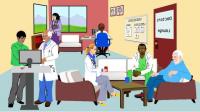You are only seeing posts authors requested be public.
Register and Login to participate in discussions with colleagues.
Telehealth, what does it mean?
Public
 With tongue in cheek some might say it was about time we made more use of the tech we've got and now here we are all using telehealth. What does it mean? What does it look like? How does it work?
With tongue in cheek some might say it was about time we made more use of the tech we've got and now here we are all using telehealth. What does it mean? What does it look like? How does it work?
What does Telehealth look like today?
The biggest change is doctors can bill for services provided as Telehealth. After decades of no pay for phone calls to patients or family in the normal course of providing medical care it is welcome and long overdue, ask any doctor including those that are retired.
Are there other health care providers that can also bill Telehealth services to MSP, such as naturopaths, chiropractors and physiotherapists?
How are Telehealth services delivered?
Many of these are likely telephone calls, connected either at the time of the call or with call backs or scheduled calls. Some may be video calls. Are they conducted from the office or outside the office.
Patients may already be familiar with video calling apps on their phones. What apps are being used and how do they rate?
Is it ok to use WhatsApp or Facebook Messenger or Skype or other course and meeting software apps like Zoom and more for Telehealth services?
Whatever connection is used, is it secure and are there risks to unauthorized exposure of the connection or personal medical information that the patient must be made aware of and informed consent obtained. Could the connection be subject to listening in or wire-tapping or does end-to-end encryption ensure it cannot be deciphered?
End-to-End Encryption and Meta-Data
While apps may provide end-to-end encryption preventing eavesdropping on the content of the call, the metadata of the connecting parties may be treated and used differently by the app provider whether it is Facebook, Google, Microsoft or others.
The use of metadata for advertising and influence has shown no evidence of abatement. One might imagine combining metadata of doctors and specialists with a person's demographics and possibly facebook status and other web posts to tailor advertisements or related content based on the monetary and other objectives of the company.
What health provider services can be billed to the Provincial Government?
What other health providers in addition to doctors can bill Telehealth services to the Provincial Government? Are naturopaths, chiropractors and physiotherapists able to provide billable Telehealth services and how are they conducted?
Provincial Gov data on use of Telehealth services
The Provincial Government might provide data to the public on the rise in use of Telehealth billing service codes.
We can do a survey
Anyone interested could do a survey on doclounge to ask amongst doctors and/or the public or make it public later, the survey tool is here.
What does Telehealth look like today?
What percent are phone calls and video calls with breakdown of apps used, easy of use, maybe even satisfaction, although in times of crisis satisfaction levels tend to be rated higher.
Is the face of Telehealth meeting the health care needs of patients?
Will Telehealth services be overused? Will it cost Provincial governments more than anticipated?
Weblinks
Virtual Health Toolkit from BC Provincial Health Services Authority (PHSA).
http://www.phsa.ca/health-professionals/professional-resources/office-of...
This is a good resource for doctors and their offices considering Telehealth. It also includes this advice that everyone should consider.
Help preserve network bandwidth for critical business applications
With clinicians using the Virtual Health solutions featured in this toolkit, there will be an increased demand on the organization’s network bandwidth. Here's how you can help:
- Corporate device, no Wi-Fi: Use your corporate device and turn off Wi-Fi. Rogers and TELUS have suspended data limits for corporate devices.
- Personal device and plan: Use your own mobile device and personal data plan.
- Wi-Fi: As a last resort. Only use your health authority Wi-Fi when you don’t have available data or a landline wired network.
Pros and Cons of Telehealth Nursing: What You Need to Know, https://tigerconnect.com/blog/pros-and-cons-of-telehealth-nursing-what-y...
The Future of Telehealth Is Closer Than You Think, https://wahospitality.org/blog/the-future-of-telehealth-is-closer-than-y...
Solving the riddle: how telehealth can make Canada a leader in timely healthcare, https://www.getmaple.ca/blog/telehealth-canada/
Telehealth services increasingly popular with consumers and insurers, https://braceworks.ca/2016/02/21/health-tech/telehealth-services-increas...
Would More Telehealth Bring New Privacy, Security Concerns? https://www.careersinfosecurity.com/would-more-telehealth-bring-new-priv...





Zoom privacy backlash just getting startedPublic
FYI, https://www.wired.com/story/zoom-backlash-zero-days/
"Zoom isn't the only video conferencing option. It's free to use, has an intuitive interface, and can accommodate group video chats for up to 100 people. There's a lot to like. By contrast, Skype's group video chat feature only supports 50 participants for free, and live streaming options like Facebook Live don't have the immediacy and interactivity of putting everyone in a digital room together. Google offers multiple video chat options—maybe too many, if you're looking for one simple solution.
At the same time, recent findings about Zoom's security and privacy failings have been legitimately concerning. Zoom's iOS app was quietly—and the company says accidentally—sending data to Facebook without notifying users, even if they had no Facebook account. The service pushed a fix late last week. Zoom also updated its privacy policy over the weekend after a report revealed that the old terms would have allowed the company to collect user information, including meeting content, and analyze it for targeted advertising or other marketing. And users have been creeped out by Zoom's attention tracking-feature, which lets the meeting host know if an attendee hasn't had the Zoom window in their screen's foreground for 30 seconds."
During the pandemic, a type of online abuse known as Zoombombing, in which trolls abuse Zoom's default screen-sharing settings to take over meetings—often with racist messages or pornography—has also spiked. Zoom offers tools to protect against that sort of assault, ..."
ZOOM versus SIGNAL et al.Public
I've tried Zoom once and can say that it's easy to install and operate. But the privacy issue concerns me greatly. Signal seems to be a good alternative, with end-to-end encryption. It seems the US security authorities (NSA, CIA &c) hate it which, in my mind, makes it very attractive. I'm set up for Signal but haven't tried it yet.
Chris
Telehealth has its limitsPublic
An interesting article in Wired magazine explores the limits of telemedicine
https://www.wired.com/story/opinion-that-weird-pain-in-your-nuts-and-the...
"... To be sure, telemedicine has incredible value in the reaches of mental health, in which human connection is the foundation of treatment. A doctor can also reliably share a lab result or medical image and help patients make decisions based on them over the screen. Tele-pathology, tele-dermatology, tele-radiology—all were doing handsomely long before entire health systems tried to conserve the resource of physical distance.
But telehealth has its limits, some of them user-generated. Beyond basic technological illiteracy, many doctors and patients are just not good on a phone or webcam. Some don’t know how to fill awkward silences, others don’t know how to stop filling them. In person, we can use the indescribable cues that come from physical presence to regulate the back and forth. But on the phone, here we sit, alone, with our words.
... For one, we lack a common language for the location of pain.
... We also lack a common language for pain itself. Pain is real, but also subjective.
... reassurance is a common treatment, and here too physical presence communicates a common language better than any webcam. Incidentally, this is also true of other aspects of medicine and life, from cancer discussions to airline customer service. Perhaps physical presence reassures so much better because when you occupy a space with another, you know they cannot abandon your cause except by force or sneaking out the back, both choices curbed by some innate guilt.